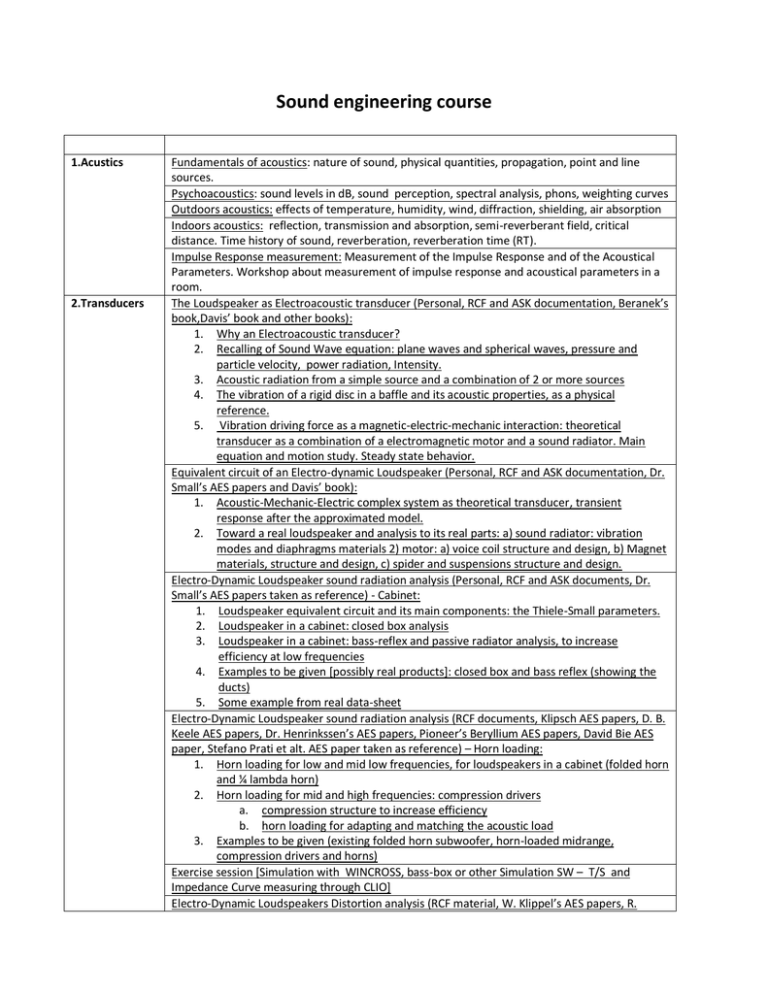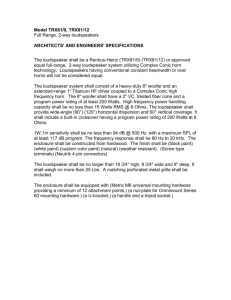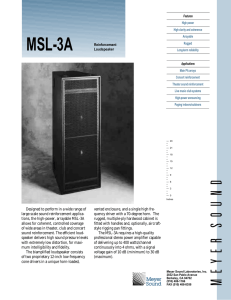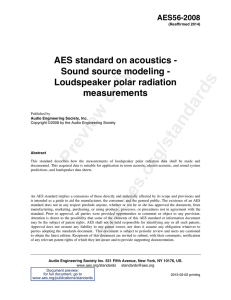Sound engineering course
advertisement

Sound engineering course 1.Acustics 2.Transducers Fundamentals of acoustics: nature of sound, physical quantities, propagation, point and line sources. Psychoacoustics: sound levels in dB, sound perception, spectral analysis, phons, weighting curves Outdoors acoustics: effects of temperature, humidity, wind, diffraction, shielding, air absorption Indoors acoustics: reflection, transmission and absorption, semi-reverberant field, critical distance. Time history of sound, reverberation, reverberation time (RT). Impulse Response measurement: Measurement of the Impulse Response and of the Acoustical Parameters. Workshop about measurement of impulse response and acoustical parameters in a room. The Loudspeaker as Electroacoustic transducer (Personal, RCF and ASK documentation, Beranek’s book,Davis’ book and other books): 1. Why an Electroacoustic transducer? 2. Recalling of Sound Wave equation: plane waves and spherical waves, pressure and particle velocity, power radiation, Intensity. 3. Acoustic radiation from a simple source and a combination of 2 or more sources 4. The vibration of a rigid disc in a baffle and its acoustic properties, as a physical reference. 5. Vibration driving force as a magnetic-electric-mechanic interaction: theoretical transducer as a combination of a electromagnetic motor and a sound radiator. Main equation and motion study. Steady state behavior. Equivalent circuit of an Electro-dynamic Loudspeaker (Personal, RCF and ASK documentation, Dr. Small’s AES papers and Davis’ book): 1. Acoustic-Mechanic-Electric complex system as theoretical transducer, transient response after the approximated model. 2. Toward a real loudspeaker and analysis to its real parts: a) sound radiator: vibration modes and diaphragms materials 2) motor: a) voice coil structure and design, b) Magnet materials, structure and design, c) spider and suspensions structure and design. Electro-Dynamic Loudspeaker sound radiation analysis (Personal, RCF and ASK documents, Dr. Small’s AES papers taken as reference) - Cabinet: 1. Loudspeaker equivalent circuit and its main components: the Thiele-Small parameters. 2. Loudspeaker in a cabinet: closed box analysis 3. Loudspeaker in a cabinet: bass-reflex and passive radiator analysis, to increase efficiency at low frequencies 4. Examples to be given [possibly real products]: closed box and bass reflex (showing the ducts) 5. Some example from real data-sheet Electro-Dynamic Loudspeaker sound radiation analysis (RCF documents, Klipsch AES papers, D. B. Keele AES papers, Dr. Henrinkssen’s AES papers, Pioneer’s Beryllium AES papers, David Bie AES paper, Stefano Prati et alt. AES paper taken as reference) – Horn loading: 1. Horn loading for low and mid low frequencies, for loudspeakers in a cabinet (folded horn and ¼ lambda horn) 2. Horn loading for mid and high frequencies: compression drivers a. compression structure to increase efficiency b. horn loading for adapting and matching the acoustic load 3. Examples to be given (existing folded horn subwoofer, horn-loaded midrange, compression drivers and horns) Exercise session [Simulation with WINCROSS, bass-box or other Simulation SW – T/S and Impedance Curve measuring through CLIO] Electro-Dynamic Loudspeakers Distortion analysis (RCF material, W. Klippel’s AES papers, R. 3.Electronics 4.Sound systems Vaucher AES paper) 1. Distortion types 2. Main Distortion Causes analysis 3. Countermeasures against distortion: passive and active approaches Loudspeakers measuring and characterization techniques (RCF, ASK material and M. Gander’s AES papers) 1. Anechoic room measurements 2. Impedance measurements 3. Power handling 4. Data-sheet reading example Loudspeaker systems: topologies, materials and technologies; multi-way systems and crossovers. Loudspeaker systems: cabinets, directivity and radiation diagrams; loudspeaker arrays. Introduction: electronic systems; analog and digital signals. Circuit analysis basic: Kirchoff and Ohm laws; Thevenin theorem, frequency response. Amplifier: linear amplifier basic concepts. Signal amplifiers: operational amplifiers. Filters: passive analog filters; active filters; Signal amplifiers: MOSFET, common source and source follower topologies. Signal amplifier topologies: common source, source follower. Power amplifiers basics: efficiency, distortion, matching, feedback stability and compensation. Linear versus switching amplification and basic scheme of a class D amplifier: power losses considerations, PWM modulation, dead time insertion. No ideality that introduce THD. Audio switching topologies: half bridge and full bridge, other Amplifier classes, series and parallel hybrid amplifier. Advantages and disadvantages. Class D amplifier control. Open loop and closed loop operations. Voltage and current feedback. Self-oscillating class-D power amplifiers. Output filter considerations. Brief EMI consideration. New trends in audio amplification: multilevel solutions, sigma-delta modulation. Examples of voltage/current waveforms of different kind of switching audio amplifiers. DSP Fundamentals 1: Discrete-Time signal & systems, Linear time-invariant (LTI) systems and linear convolution, LTI systems properties, Linear constant-coefficient difference equations , Frequency-domain representation of discrete time signals & systems. DSP Fundamentals 2: Representation of sequences by Fourier Transforms (DTFT), The zTransform, Transform Analysis of LTI Systems Sampling of continuous-time signal DSP Fundamentals 3: Structure for Discrete-Time Systems, The discrete Fourier series, The discrete Fourier transform Fourier Analysis Using the DFT DSP Fundamentals 4: Discrete-Time Filter Design techniques, Discrete-Time Filter Design from Continuous-Time Filters, Impulse invariance, Bilinear transformation, Audio filtering, A/D and D/A Conversion, Finite Precision Numerical Effects Audio Effects: IIR/FIR Comb filters, Delay lines/effects, Nonlinear processing(Range compressor) Digital Signal Processors: Internal Architecture. Commercial DSP. Fixed vs floating architecture. Commercial A/D and D/A: how to choose and how to read a datasheet. Sample vs block processing A real case: realization of some digital effects on a real DSP. Sound Reinforcement System design , Line array : 1. Line array as an integration from the multy way system concept and multiple source directivity control. 2. Equalization , total gain of the system , audio chain. Line array system example. Speaker Lab software is used to re-design the Array from the acoustic baloon measurements of the single loudspeakers , EQ curves and delays , geometry positioning of the single components relative to the array , directivity control with dsp. Exploring different design choice. Sound Reinforcement Systems: multi-way speaker systems, subwoofers, line arrays, digital steering arrays. Sound reinforcement systems: speaker systems and directivity baluns. EASE 4.3 acoustic simulation software: how single transducers with different polar characteristics perform in a simulated environment. Comments and discussions on results. Individual exercise based on the introduction of single speakers in existing architectural models. Sound reinforcement systems design: how to choose the speaker systems and relevant positioning inside an EASE 4.3 model, according to power and directivity requirements. Applications and examples. Sound reinforcement systems design: dimensioning and installation of pre-amplification and power amplification devices, examples of systems. Sound reinforcement systems design: how to design a sound system by using EASE 4.3 acoustic simulation software; introduction to architectural modeling. By working on existing models it will be discussed about selecting and positioning the speakers and how to optimize the system. Analysis of the final results Exercise based on modeling a real environment equipped with an audio system. Comparison between simulated data and measured data (by using EASERA software and calibrated instruments). Sound Reinforcement Systems design: audio networking. Technologies and infrastructures required. Transmission protocols. Applications and examples. Final exercise in open field



